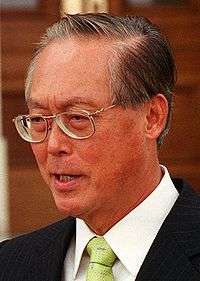Singaporean general election, 1991
| |||||||||||||||||||||||||||||||||||||||||||||||||
81 seats to the Parliament of Singapore Only 40 seats contested; 41 seats needed for a majority | |||||||||||||||||||||||||||||||||||||||||||||||||
| Turnout | 95.0% | ||||||||||||||||||||||||||||||||||||||||||||||||
| |||||||||||||||||||||||||||||||||||||||||||||||||
| |||||||||||||||||||||||||||||||||||||||||||||||||
.svg.png) |
| This article is part of a series on the politics and government of Singapore |
| Constitution |
| Foreign relations |
|
Related topics |
General elections were held in Singapore on 31 August 1991. The result was a victory for the People's Action Party, which won 77 of the 81 seats. Voter turnout was 95.0%, although this figure represents the turnout in the 25 constituencies to be contested,[1] with PAP candidates earning walkovers in the other 41.
Background
This was Prime Minister Goh Chok Tong's first election as leader of the PAP after Lee Kuan Yew stepped down in 1990. PM Goh decided to call a snap election merely three years after the last GE, setting Parliament's shortest term ever, to court a fresh mandate. However, it lost an unprecedented four seats, the biggest number since the 1963 GE, and its share of votes fell for the third consecutive time since 1984. The Singapore Democratic Party (SDP) added two more spoils to the seat retained successfully by leader Chiam See Tong, becoming the main opposition party in Parliament. Eight out of nine SDP candidates came in among the top ten opposition candidates. The Workers' Party of Singapore (WP) made its second in-road into the legislature with the victory of its organising secretary Low Thia Khiang, who would years later become WP secretary-general and leader.
At a post-election press conference on the night of 31 August, PM Goh glumly attributed the loss to his "open and consultative style of government" and pledged to re-evaluate his style. Sizes of Group Representation Constituencies were increased from three to four seats each. Since the introduction of the Non-Constituency Member of Parliament scheme in 1984, this was the first GE with no NCMP seats offered as the four opposition seats exceeded the minimum of three NCMP seats allotted. Therefore, the narrow defeat of WP's Eunos GRC team, helmed by Dr Lee Siew Choh again, did not see to Dr Lee's return as NCMP. This was his final legislature and electoral presence as he resigned from WP and retired from politics in 1993. The maximum of six Nominated MPs were appointed for this term, up from two Nominated MPs previously.
Changes to seats
Existing GRCs
Another group of changes were necessary as it increased from 3 to 4. Some of them are in the basis of expansion due to the fast growth of towns.
- Paya Lebar division was merged into Aljunied GRC.
- Fengshan and Siglap divisions were merged into Bedok GRC.
- Punggol division was merged into Cheng San GRC.
- MacPherson division was merged into Marine Parade GRC.
New GRCs
- Ang Mo Kio GRC was formed from Ang Mo Kio SMC, Teck Ghee SMC, Yio Chu Kang SMC and Kebun Baru SMC.
- Kampong Glam GRC was formed from Cairnhill SMC, Kampong Glam SMC, Kim Seng SMC and Moulmein SMC.
- Tanjong Pagar GRC was formed from Tanjong Pagar SMC, Telok Blangah SMC, and some from Tiong Bahru GRC.
- Thomson GRC was formed from Thomson SMC and Serangoon Gardens SMC.
Division removals
- Alexandra (split into 2 and merged into Brickworks and Queenstown)
Tan Soo Khoon was shifted to Kampong Chai Chee. - Henderson (merged into Radin Mas)
Chng Hee Kok was shifted to Changkat South. - Pasir Panjang (merged into Brickworks)
Abbas bin Abu Amin retired. - Tanah Merah (merged into Siglap)
Ibrahim bin Othman was shifted to Bishan North. - Whampoa (split and absorbed into 3 constituencies: Moulmein, Kim Keat and Kallang)
Augustine Tan retired.
New divisions
The newer divisions are those because of developments of Simei, Jurong West, Bishan and Pasir Ris respectively.
- Bishan East (from Serangoon Gardens)
- Bishan North (from Thomson)
- Changkat South (from Changkat)
- Hong Kah West (from Hong Kah South)
- Pasir Ris (from Tampines North)
New and retiring candidates
| Retiring Candidates | New Candidates |
|---|---|
| Abdul Nasser Kamaruddin, MP for Hong Kah GRC Abbas bin Abdul Ramin, MP for Pasir Panjang GRC Augustine Tan, MP for Whampoa Chua Sian Chin, MP for MacPherson Dhanabalan Suppiah, MP for Kallang (and constituency abolished). Dixie Tan, MP for Ulu Pandan Hong Hai, MP for Bedok GRC (Kampong Chai Chee) Koh Lam Son, MP for Telok Blangah Lawrence Sia, MP for Moulmein (also called Sia Khoon Seng) Ng Kah Ting, MP for Punggol Philip Tan, MP for Paya Lebar Wan Hussin bin Haji Zoohri, MP for Aljunied GRC | Harun bin Abdul Ghani, 52 Ho Peng Kee, 37 Ker Sin Tze, 46 Koo Tsai Kee, 36 Lim Hng Kiang, 37 Matthias Yao, 35 Michael Lim, 30 Mohammad Maidin bin Packer, 34 Sinakaruppan Ramasamy, 32 Umar Abdul bin Hamid, 31 |
Results
| Party | Votes | % | Seats | +/– |
|---|---|---|---|---|
| People's Action Party | 477,760 | 61.0 | 77 | –3 |
| Workers' Party | 112,010 | 14.3 | 1 | +1 |
| Singapore Democratic Party | 93,856 | 12.0 | 3 | +2 |
| National Solidarity Party | 57,306 | 7.3 | 0 | 0 |
| Singapore Justice Party | 15,222 | 1.9 | 0 | 0 |
| Singapore Malay National Organisation | 12,862 | 1.6 | 0 | 0 |
| Independents | 14,596 | 1.9 | 0 | 0 |
| Invalid/blank votes | 21,961 | – | – | – |
| Total | 805,573 | 100 | 81 | 0 |
| Source: Nohlen et al. | ||||
References
- ↑ Dieter Nohlen, Florian Grotz & Christof Hartmann (2001) Elections in Asia: A data handbook, Volume II, p255 ISBN 0-19-924959-8


